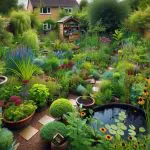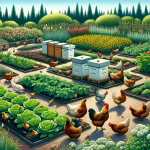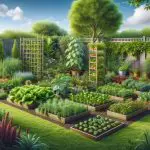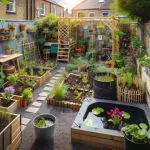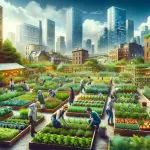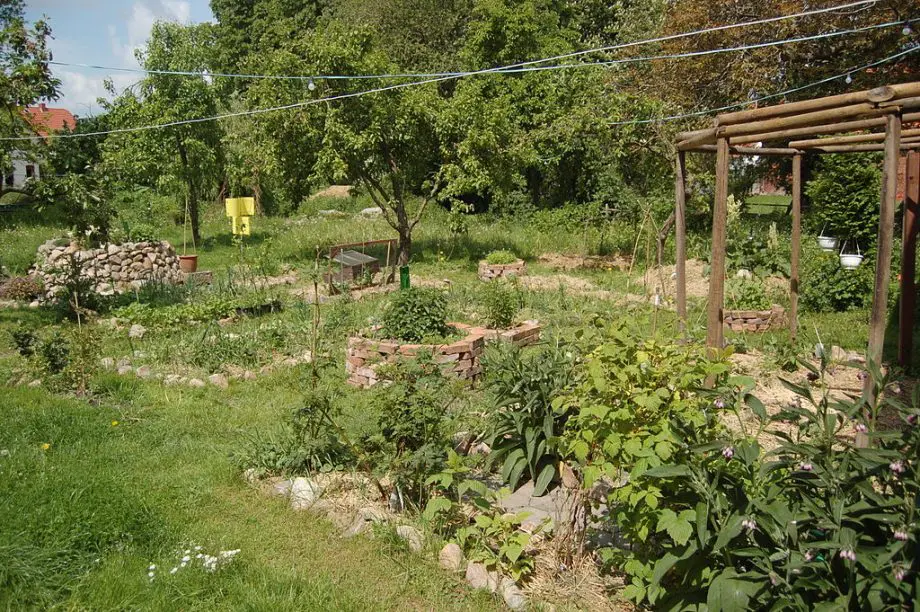
Dive into our guide on how to design a permaculture layout for beginners your first step to a sustainable, thriving garden!
Permaculture Design Key Takeaways:
- Permaculture layout design begins with observing your garden’s natural ecosystem.
- Focus on integrating native plants, water conservation, and sustainable practices.
- Start with a simple plan for small spaces.
- Incorporate elements like rain gardens, composting, and efficient use of resources for a thriving, eco-friendly garden.
Ever wondered how to design a permaculture layout for beginners? Well, you’re in the right place!
We’re here to guide you through creating a sustainable garden, even if you’re just starting out.
Let’s embark on this green journey together!
How to Design a Permaculture Layout for Beginners
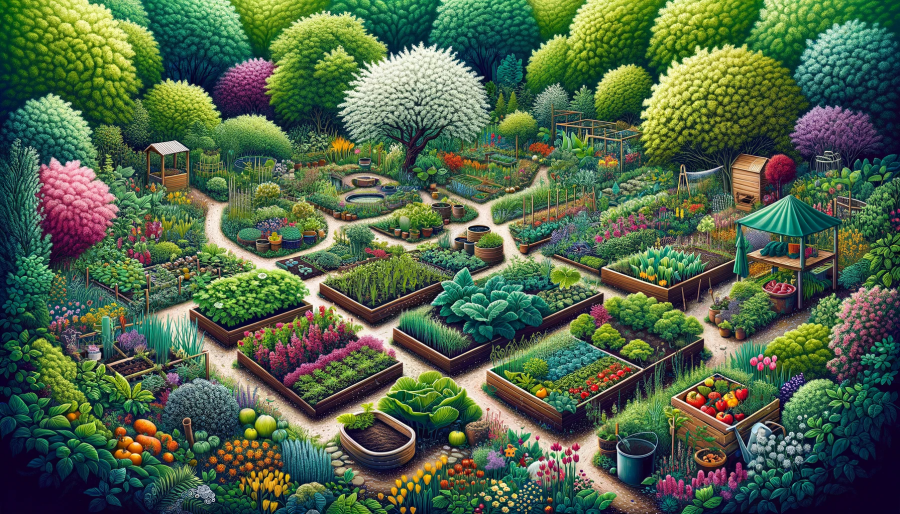
Permaculture is a blending of the concepts of “permanent” and “agriculture,” revolutionizing our approach to gardening.
It’s more than just cultivating a vegetable garden or planting fruit trees.
It’s about creating a self-sustaining ecosystem that aligns with nature’s rhythms.
This article delves into the first steps of designing a permaculture garden, focusing on small gardens and home gardens, and emphasizing the integration of permaculture principles for a harmonious balance with nature.
Whether you are starting a kitchen garden or planning a food forest, these initial steps are your roadmap to a thriving natural ecosystem.
Permaculture is an approach to land management and settlement design that adopts arrangements observed in flourishing natural ecosystems. It includes a set of design principles derived using whole-systems thinking. Wikipedia
Understanding Permaculture and Its Principles
Let’s start on a journey into the heart of sustainable gardening with our introduction to ‘Understanding Permaculture and Its Principles.’
Perfect for beginners, this section unravels the essence of permaculture – a harmonious blend of nature and gardening.
Here, we’ll explore the foundational principles that transform ordinary backyards into thriving ecosystems, guiding you through the steps to create your own sustainable oasis.
Let’s delve into the world of permaculture and discover how simple principles can lead to profound environmental harmony.
An Introduction to Permaculture
Permaculture goes beyond traditional gardening, merging “permanent” and “agriculture” into a holistic design system.
This approach, rooted in the basic principles of permaculture, transcends mere vegetable gardening, encompassing the creation of sustainable, interdependent systems in small areas like home gardens.
Ideal for both beginners and experienced gardeners, permaculture gardening integrates native plants and perennials into a living, breathing ecosystem.
It’s an efficient way to grow your own food, reduce waste, and create a natural balance.
The 12 Principles of Permaculture
1. Observe and Interact:
The first step in any permaculture design process, especially in small gardens, is to observe the local climate and natural systems.
This involves understanding your garden area’s water flow, soil types, and native plants.
Observing these elements over the seasons, particularly during cold winters or short growing seasons, is crucial.
2. Catch and Store Energy:
This principle emphasizes utilizing natural resources like rainwater and sunlight.
In a small space, this could mean setting up a rain garden or positioning garden beds to maximize sun exposure.
3. Obtain a Yield:
Essential in kitchen gardens, this principle focuses on producing food, whether through vegetable gardens, fruit trees, or medicinal herbs.
The yield could also be aesthetic or environmental, like attracting beneficial insects.
4. Apply Self-Regulation and Accept Feedback:
This involves learning from the garden’s performance.
For example, if certain plants consistently fail, it might be time to try alternative species more suited to your garden’s conditions.
5. Use and Value Renewable Resources and Services:
In small gardens, this could involve using compost made from food waste and grass clippings or planting nitrogen-fixing plants as green manure.
6. Produce No Waste:
A key aspect of permaculture garden design is to minimize waste. In permaculture, everything has a place.
Dead plants become valuable compost, and kitchen scraps are recycled back into the garden.
7. Design From Patterns to Details:
Permaculture designers look at the whole site before focusing on details.
For instance, the layout of raised beds in a small garden should align with natural water flow and sunlight patterns.
8. Integrate Rather Than Segregate:
Companion planting is a great example, where different types of plants support each other, reducing the need for chemical interventions.
9. Use Small and Slow Solutions:
This principle advises starting with manageable steps, which is particularly relevant for beginners or those working with a small area.
10. Use and Value Diversity:
Diversity in plant species and garden areas leads to a more resilient system.
This includes mixing fruit shrubs with tall trees and delicate plants in a forest garden.
11. Use Edges and Value the Marginal:
This could mean utilizing the edges of a property or the front of an apple tree for growing medicinal herbs.
12. Creatively Use and Respond to Change:
Permaculture is about adapting to local conditions and changes.
For instance, if a new building shades part of your garden, it might become a potential food-growing zone for shade-loving plants.
Permaculture Design Process
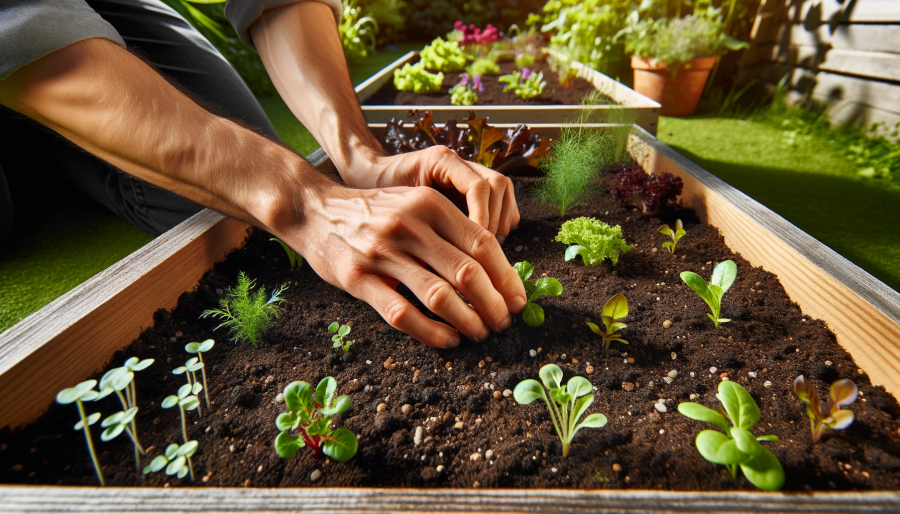
Step 1: Observe:
- Observing your garden’s natural ecosystem is a fundamental first thing to do in permaculture.
- For a small garden, this involves understanding local conditions like soil types, natural predators, and water sources.
- It’s about seeing the whole site as a potential food-growing zone and recognizing patterns like water flow or sunlight paths.
- This step, often overlooked in modern agricultural methods, is crucial for permaculture’s success, especially in the northern hemisphere with its distinct seasons and varying conditions.
Step 2: Vision:
- The vision stage is about dreaming big but practical. Think of what your ideal kitchen garden or food forest would look like.
- Consider integrating elements like chicken coops, raised beds, or a small area dedicated to perennial plants.
- This vision should reflect permaculture design principles, focusing on sustainability and a continuous cycle of growth and renewal.
- It’s the perfect time to incorporate ideas like a rain garden, green manure, or designing around a water source.
Step 3: Research:
- Research is crucial in the permaculture design process, particularly for beginners.
- This step involves digging deeper into the specific needs of your garden. It’s about understanding the microclimate, and soil quality, and identifying potential challenges like soil erosion or a short growing season.
- Research can also include learning from permaculture courses or books, gathering information about local species, and understanding how various elements like tall trees or garden beds will interact within your own permaculture garden.
- This phase is about transforming your vision into a practical application, considering every detail from the base map of your property to the specific types of organic matter you’ll use.
Step 4: Planning and Development:
- Now, it’s time to translate your research into a concrete plan. This involves creating physical maps of the property, considering factors like sunlight exposure, water flow, and soil types.
- In small gardens, this might mean designing a kitchen garden with companion planting or planning a small food forest with fruit trees and perennial plants.
- The planning should account for seasonal variations, particularly in the northern hemisphere, ensuring that your garden remains productive even during the winter months.
- This step is about streamlining patterns and organizing your garden areas efficiently, making the most of every space.
Step 5: Implementation:
- The implementation phase is where you start to bring your permaculture design to life.
- Begin with manageable steps, focusing first on high-impact areas like the kitchen garden or areas designated for fruit trees.
- Use organic materials wisely, establish your garden beds, and start incorporating native plants and beneficial insects.
- Remember, permaculture is a continuous cycle – it’s not just about setting things up but also about maintaining and evolving your garden.
- Even in a small space, the goal is to create a self-sustaining system that mimics natural ecosystems.
Step 6: Observation and Adaptation:
- After implementation, the permaculture process comes full circle back to observation.
- Monitor how your garden evolves, noting any changes in plant growth, soil quality, and the effectiveness of your design.
- Be ready to adapt and tweak your system. For instance, if certain plants aren’t thriving in one area, consider relocating them or replacing them with more suitable varieties.
- Permaculture is about learning from nature and being flexible to change, ensuring that your garden not only survives but thrives in harmony with its natural surroundings.
Zone Design in Permaculture
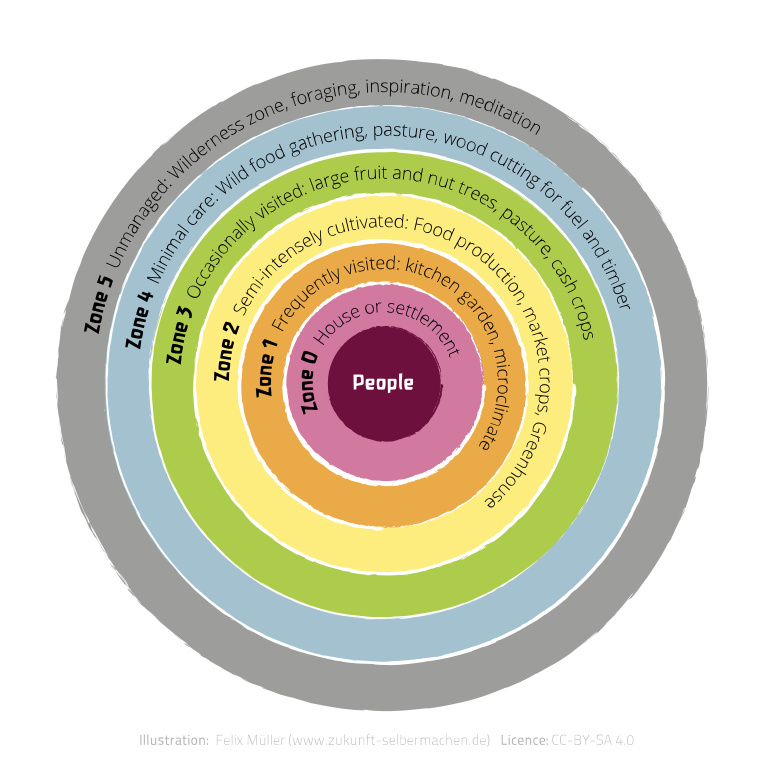
In permaculture, effective space utilization is achieved through the concept of zoning.
This method categorizes different areas of your garden based on usage frequency and required maintenance, making it particularly suitable for small gardens and home gardens.
- Zone 0: The Home: This zone encompasses your living spaces, where daily activities occur. It’s where you process and store food from your garden and start seedlings indoors. Consider integrating rainwater collection systems on your roof, which can be a vital water source for your garden.
- Zone 1: Kitchen Garden: Located close to the house, this zone is for intensive garden beds that require daily attention. It’s the perfect place for a kitchen garden, growing herbs and vegetables you use regularly. This area should be designed for ease of access and maintenance, making it a great place for raised beds and small fruit trees.
- Zone 2: Larger Gardens and Animals: Here, you might have medium-intensity garden areas like larger vegetable beds, orchards, and spaces for animals that need frequent attention. These could include chicken coops, which contribute to soil fertility through their manure, and areas for perennial plants that require less effort but provide valuable yield.
- Zone 3: Semi-Wild Areas: This zone is for low-intensity farming, like field crops and grazing animals. It requires less frequent visits and is more aligned with a natural growing system. You might include food crops that need less attention, or designate this area for natural predators that help maintain a healthy ecosystem in your garden.
- Zone 4 and 5: Wild Areas: These zones represent the transition to complete wilderness, with minimal human intervention. They’re important for observing natural systems and learning from them. Zone 4 might include areas for foraging wild food, while Zone 5 is left undisturbed, acting as a reservoir of biodiversity and natural beauty. These zones are crucial for maintaining the ecological balance and ensuring your garden is a part of the larger natural ecosystem.
Practical Permaculture Tactics for Beginners
Implementing permaculture in your garden, especially in small spaces, involves a set of practical tactics that align with permaculture principles.
These tactics make your garden not only a source of food but also a self-sustaining ecosystem.
Grow Your Own Food:
Central to permaculture is growing food that your family enjoys and consumes regularly.
This could include a variety of vegetables, fruits, and herbs in your kitchen garden.
The focus should be on what you love to eat, ensuring your garden is both a source of nourishment and joy.
Incorporate fruit trees and perennial plants in your design system, creating a diverse and productive garden even in a small area.
Create and Capture Resources:
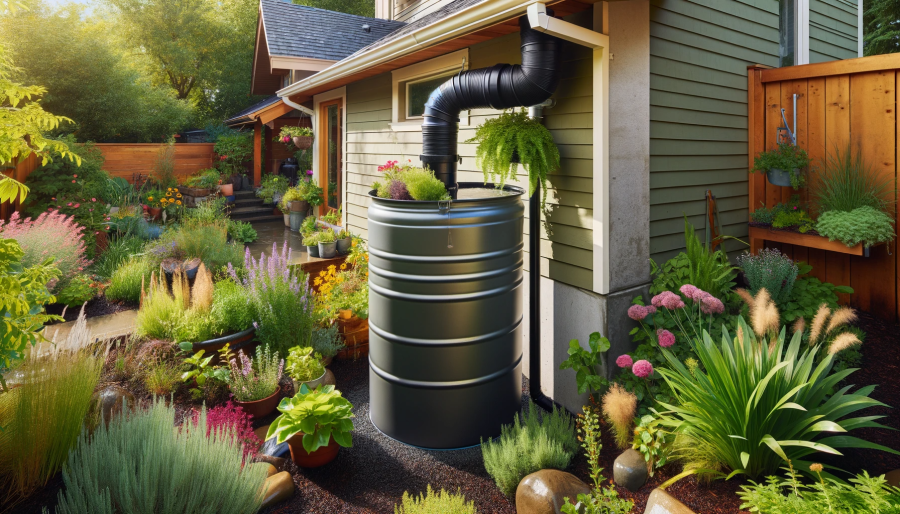
Permaculture is about maximizing the resources available on your property.
This includes capturing rainwater for irrigation, using solar panels for energy, and utilizing the heat from compost to benefit other parts of your garden, like warming chicken coops.
Each resource should serve multiple purposes, contributing to the garden’s overall efficiency and productivity.
Design for Resource Efficiency:
The design of your permaculture garden should minimize the need for external inputs.
Position structures to capture natural sunlight, use high-efficiency windows to regulate temperature and landscape your garden to optimize water usage.
These design choices not only reduce your reliance on external resources but also enhance the sustainability of your garden.
Reduce Waste:
Permaculture emphasizes the importance of a closed-loop system where waste from one process becomes a resource for another.
Compost your organic waste to enrich the soil, use excess wood for creating hugelkultur beds, and recycle animal manure as fertilizer.
These practices ensure that waste is minimized, and every element in your garden contributes to the overall health and productivity of the ecosystem.
FAQs about Permaculture for Beginners
Permaculture, with its roots in creating sustainable and self-sufficient ecosystems, often raises questions, especially among beginners.
Here are some frequently asked questions to provide clarity and guidance.
Q: What does permaculture mean?
A: Permaculture is a design framework aimed at establishing sustainable and self-sustaining agricultural systems and human settlements.
It emphasizes the harmony between human activities and the natural world, leveraging patterns and relationships found in nature.
The approach focuses on diverse and perennial plantings, integrated crop and animal systems, and creating microclimates to enhance natural ecosystems.
It strives to minimize reliance on non-renewable resources and maximize the efficiency of on-site resources, promoting a sustainable balance between human needs and environmental health.
Q: What are the basics of permaculture?
A: The core of permaculture lies in several key practices:
- Observing and interacting with the environment to understand natural relationships.
- Catching and storing energy, like using renewable sources and conserving water.
- Obtaining yields from diverse, self-sustaining plants and animals for food, medicine, and other resources.
- Applying self-regulation and accepting feedback to adapt the system as needed.
- Using renewable resources and creating closed-loop systems to minimize waste.
- Designing from patterns observed in nature.
- Integrating various system elements to create synergistic relationships.
- Embracing small and gradual solutions for long-term sustainability.
- Valuing diversity for resilience and stability.
- Utilizing and valuing marginal and edge areas as productive zones.
- Creatively responding to change and using it for evolutionary growth.
Q: What is the main goal of permaculture?
A: Permaculture’s primary aim is to establish sustainable living environments and agricultural systems that mimic natural ecosystems.
It seeks to cater to human needs while enhancing the environment’s health and resilience.
This involves creating systems that are self-sufficient, minimizing the use of non-renewable resources, and maximizing the efficiency of local resources.
It stresses the integration of diverse, perennial plants and integrated animal and crop production.
Ultimately, permaculture aims to foster a symbiotic relationship between humans and nature, where both can thrive in a harmonious, sustainable balance, enhancing both food security and environmental stewardship.
Conclusion: Embracing Permaculture in Your Gardening Journey
The Transformative Power of Permaculture
Embarking on the journey of permaculture gardening is transformative, transcending the basics of cultivating a kitchen garden or managing small gardens.
It’s about embracing a sustainable, harmonious relationship with nature.
Aligning with Natural Ecosystems
Permaculture guides you to design and manage your garden in harmony with natural ecosystems.
This approach leads to healthier, more productive environments, adaptable to various climatic challenges, whether it’s cold winters in the northern hemisphere or regions with short growing seasons.
Observing and Adapting
By applying permaculture principles, you’ll see a shift in your garden’s operation.
It becomes a microcosm of the natural world, where every element works in unison, providing food, beauty, and a haven for wildlife.
Continuous Learning and Growth
The journey to a successful permaculture garden is one of continuous learning and adaptation.
Embrace this process with enthusiasm, and watch as your garden transforms into a thriving, sustainable ecosystem.

